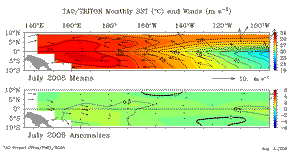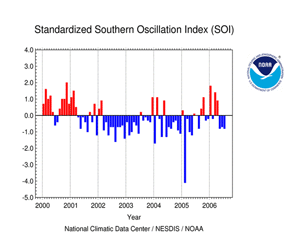NEUTRAL PHASE OF ENSO CONTINUES:
SSTs WARM IN THE EQUATORIAL PACIFIC
SSTs WARM IN THE EQUATORIAL PACIFIC
|
|
Sea-Surface
Temperatures (SSTs) and
Mixed-Layer Conditions: Sea-Surface Temperatures (SSTs) increased across most of the equatorial Pacific Ocean during July. Water temperatures in the mixed-layer also increased this past month, with the warmest anomalies in the eastern equatorial Pacific between 90°W and 120°W. For July, the SST anomaly in the Niño 3.4 Index region was +0.11°C (+0.2°F), which was a slight decrease compared to the June anomaly. The SSTs in the Niño 4 Index region of the western equatorial Pacific continued to warm during July, resulting in a monthly anomaly of +0.41°C (+0.74°F) above the mean (map of Niño regions). For the most recent global ocean surface temperatures, please see the loop of satellite-derived weekly SST anomalies for July 2006. Below average SST anomalies persisted throughout the latter half of 2005 and into the first few months of 2006 in the central equatorial Pacific basin (as seen in the data from NCDC's Extended Reconstructed Sea Surface Temperature [ERSST version 2] dataset). Due to the warming of SSTs and mixed-layer temperatures in the central tropical Pacific, the 3-month running mean of the Niño 3.4 index region increased above -0.5°C in April, and has continued to remain above the long-term mean in July. (NOTE: For NOAA's official ENSO classification scheme, please see NOAA's El Niño/La Niña Index Definition and also see the CPC ENSO Diagnostic Discussion for NOAA's latest official assessment of ENSO conditions.) |
|
|
Equatorial Zonal Winds (U-Component
Winds) and Sea-Level Topography: The monthly averaged easterly trade winds were near-normal across the eastern and central equatorial Pacific during July. Weaker than normal easterly winds were observed near the Date Line, with westerly zonal winds developing in the far western Pacific (see the loop of July zonal winds). Pacific sea levels measured by the NASA/JPL Jason-1 satellite were near-average along the equatorial zone in July, as the sea level heights reflected the near-normal conditions during the month (see the 23 July 2006 sea level anomalies for the most recent overpass). |
|
|
Outgoing
Longwave Radiation (OLR): The map to the left shows the spatial pattern of global OLR (in W m-2) observed by satellite during July. Positive OLR anomalies (typically associated with La Niña) that persisted over the past several months in the equatorial western Pacific region dissipated in July, with only a small area of above average OLR remaining south of the equator near the Date Line. Convection associated with the monsoon trough and tropical cyclone activity increased north of Indonesia in the western Pacific in July. Despite the changes this past month, the 3-month averaged OLR anomalies remained positive along the equator over sections of the eastern and central Pacific, reflecting the reduced cloudiness that was observed during the latter stages of 2005/2006 La Niña. The monthly-averaged OLR Index became positive during July, although it remained near-neutral. For the month, the OLR index was +0.4 W m-2 averaged across an area centered over the Date Line in the western Pacific between 160° E and 160° W (positive OLR Index values are typically associated with La Niña conditions in this region). Note that high frequency variability in OLR is typically associated with the Madden-Julian Oscillation (MJO, which is convective activity that propagates west to east in the near-equatorial region from the Indian Ocean into the Pacific Ocean approximately every 30-60 days). The latest MJO activity can be seen in CPC's graphs of Daily MJO Indices. |
| Southern Oscillation Index
(SOI): The standardized SOI was negative in July, with a monthly averaged value of -0.8 for the month. Note that consistently negative (positive) values of the SOI are typical of El Niño (La Niña) conditions. However, the monthly values of the SOI were inconsistent during the relatively weak 2005/2006 La Niña event, fluctuating several times between near-neutral values and positive indices that were more indicative of the weak cold event. The shift to a negative SOI during the Boreal spring coincided with the development of warmer than average SSTs across the equatorial Pacific. It also coincided with a transition in the Walker Circulation to a near-neutral mean sea level pressure (MSLP) pattern. |
Additional Links
- ENSO Monitoring
- NOAA El Niño / La Niña Index Definition
- NOAA's Pacific Marine Environmental Laboratory (PMEL):
- NOAA's Climate Prediction Center (CPC):
- NOAA's Physical Science Laboratory
- NASA/JPL Ocean Surface Topography from Space
- Australian Bureau of Meteorology (BoM) Climate Driver Update
- IRI - International Research Institute
 NOAA's National Centers for Environmental Information
NOAA's National Centers for Environmental Information





 Larger image of
July OLR
Larger image of
July OLR Larger image
of May-July OLR
Larger image
of May-July OLR Larger image of July
OLR Index
Larger image of July
OLR Index